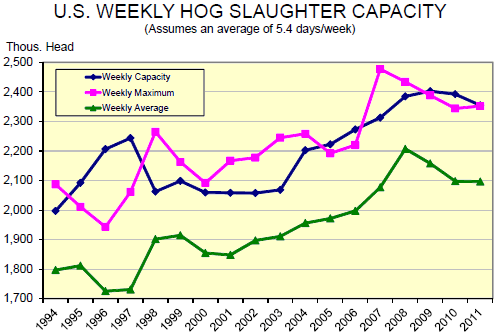CME: Cloverdale Foods to Close ND Slaughter Plant
Wednesday Jul 27 2011by ThePigSite News Desk
The plant was not large at all (600 head per day capacity) but was an important cog in the hog-pork industry in the northern plains, purchasing a good number of hogs from North Dakota, South Dakota, Montana and the Canadian Prairie Provinces over the years.
In making the announcement, company president T. J. Russell cited long term business strategy as well as the recent Minot flood as key reasons.
Mr Russell said that the plant has not processed a hog since 23 June. It was not actually damaged in the flooding but the interruption of logistics in the area prevented operations.
Mr Russell said the plant would not have water for another week. Cloverdale will continue to operate its processed meats plant in Mandan, North Dakota and cited better profit opportunities from the processing side of the business as the driver of a long-term strategy to eventually exit slaughter operations.
That is a song that has been sung many times in the pork industry. While not the first to sing it, Oscar Mayer is still the best example of a company that exited slaughter operations and simply focused on processing and leveraging valuable brand names.
Sara Lee, though still in the sow slaughter business in Newburn, Tennessee, would be another good example since it closed its West Point, MS Bryan Foods plant in March 2006. Even Hormel has stated many times that the only reason it is in the slaughter business it to provide raw materials to its processing operations and well- know brands such as Spam, Cure 81 ham and Black Label bacon. Selling fresh pork is a tough, tough business.
While only a small loss of pork slaughter capacity, the Cloverdale closure brings to light a potential pitfall for the pork industry : The industry can hardly expand given today’s packing capacity.
The chart below shows the history of US hog slaughter capacity, average weekly slaughter and the high- est slaughter day for each calendar year.

The capacity data has been compiled by Dr Steve Meyer since 1994 and has been published for the past few years by National Hog Farmer magazine. Note that the packer capacity data (the blue line) omitted a significant number of small plants until 2004 and did not include virtually all plants until 2008.
Since that time it is pretty much an enumeration of plants and their daily capacities. These weekly data assume 5.4 days of operations per week. Some individual plants exceed that level regularly and the industry as a whole can do so for a few weeks at a time but doing so over any period puts terrific stress on the workforce, logistics, plant and equipment. It also results in very wide packer margins and, usually, very low hog prices.
But note how close to capacity the highest slaughter weeks have been since 2008. There has been very little slack in the slaughter sector and, since mid-2009, packers’ gross margins on fresh pork products have been about as good as they have ever been. They have certainly stayed higher longer that at any time in the past 20 years.
Barring any other changes, next year’s capacity will be slightly larger than this year’s in spite of the Cloverdale closure due to the re-opening of the former Meadowbrook Farms plant in Rantoul, IL by Trimrite, a meat boning company based in Carpentersville, Il. The plant had a capacity of 3800 head per day when with Meadowbrook but Trimrite has mentioned lower numbers on several occasions.
Adding 10,000-12,000 per week, though, only accommodates another 500,000 to 600,000 pigs per year — or about 0.5 per cent of 2011 projected slaughter. Many forecasts have 2011 slaughter 0.5 per cent to one per cent higher than this year and Cargill’s announced plans for its Texas operations would add another one to 1.5 per cent to that level over the next three years.
Where will all of those pigs (or the ones they displace) be processed? That’s a good question at present.
Back to News

Hog producers are looking at ways of meeting new animal care requirements as they come into effect (read article)


